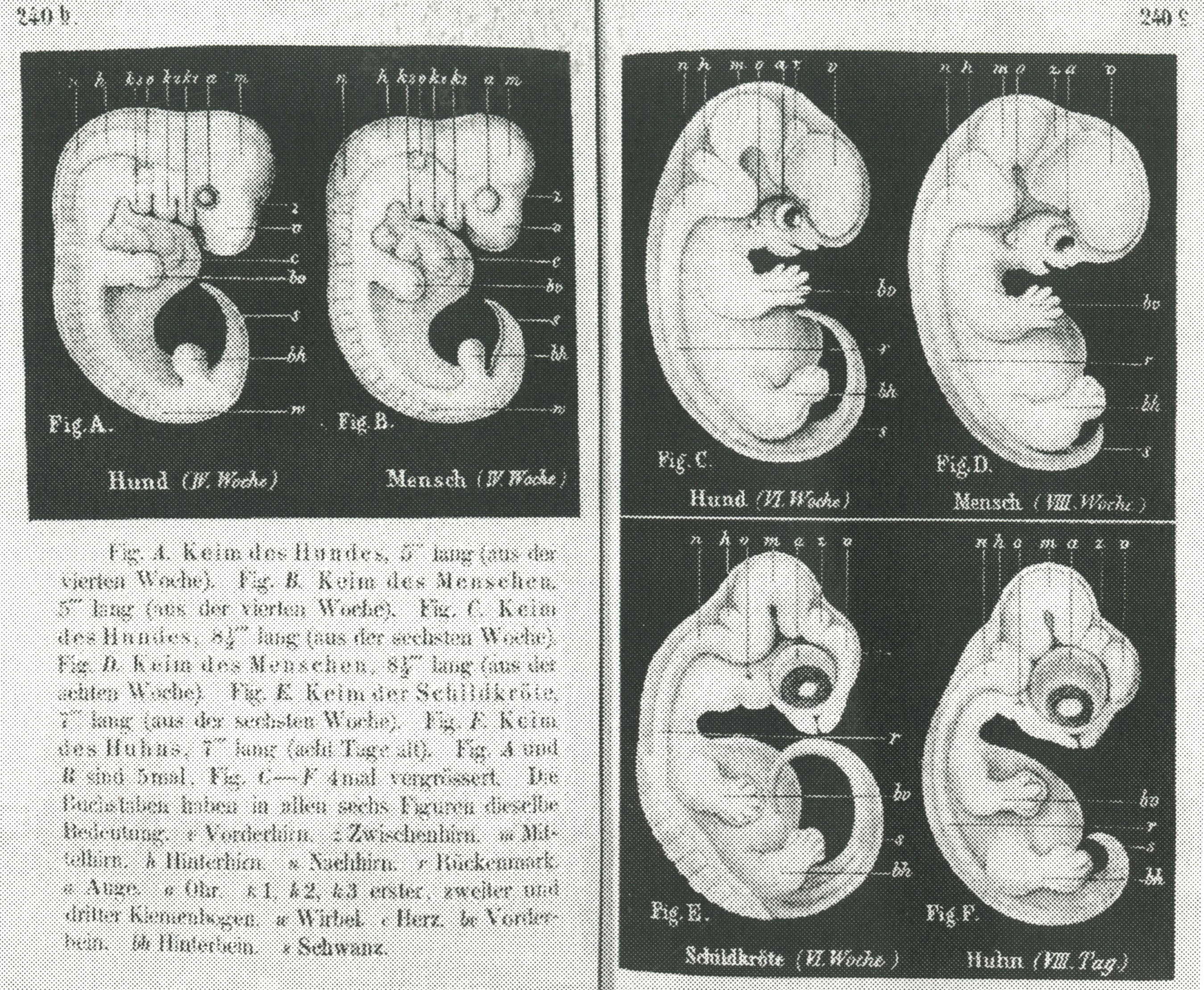Ernst Haeckel and the recapitulation of an “early” biological debate
Posted by Pablo Astudillo, on 8 December 2010
Scientists don’t spend free time to think about the changes that made possible the birth of a new way to make research. For example, how we moved from a world driven by religious and philosophical beliefs to a world demanding explanations and mechanisms? Ernst Haeckel was one of the scientists who made that change possible and, more important to us, he accomplished it from the field of developmental biology. Although this post is not intended to be a review of Haeckel’s work (that would be a daunting and overwhelming task), it is worth to mention some interesting things about this story. As many scientists at their times, Haeckel’s work was criticized and Haeckel was, indeed, heavily attacked not only by religious and conservative people, but also by other fellow scientists. We can summarize some aspects of Heckel’s view as follows: Haeckel was impressed and inspired by the work of previous scientists (being J.F. Meckel and K.E. von Baer the most important people), showing the resemblance between embryos from different animal species at early stages of development. Although Haeckel was not the first scientist to propose a resemblance of vertebrate embryos at early stages of development, Haeckel made use of this fact, often depicting embryos in his works with some degree of abnormalities (which were used by his critics to accuse him of adulterating embryos).
Ernst Haeckel formulated the known Fundamental Biogenetic Law, in which he describes the parallelism between embryonic development and the phylogenetic history, claiming that embryonic development is a rapid recapitulation of the evolution, or “ontogeny recapitulates phylogeny”. Most conservative people viewed Haeckel’s propositions as a challenge to the more religious views about the origin of man. Haeckel made comparisons between early embryos from different species; his famous drawings, that appeared in his works, especially in Natürliche Schöpfungsgeschichte, were famous at the time, and they were criticized by other scientists. Some people at the time claimed that the only evidences for this proposition were the drawings made by Haeckel, but we have to consider that experimental biology was at a sort of “very early stage of development”. Hence, Haeckel’s work was abandoned from the main stream of science, especially between the World Wars, when chemistry and physics gained much more attention. However, Haeckel’s work likely inspired many future scientists, including his students. One of them was Hans Spemann, who later made one of the most important experiments in biology. Even, when the findings of Spemann and Mangold can be considered as opposed to Haeckel’s biogenetic law (because now the embryological development is driven by hidden forces with molecular nature, and since all organisms are different, these forces should differ in nature), the work of Spemann led in time to the discovery and (partial) understanding of the Wnt pathway, which is maybe one of the most conserved signaling pathways in nature and one of the most important driving forces in embryological development, validating Haeckel’s work: indeed, embryological development involves the expression and function of conserved genes through evolution. This realization brought Haeckel’s work one more time into the public attention, and once again, critics to his work appeared, with high press coverage at the time.
 Image attributed to Ernst Haeckel, published in his work Natürliche Schöpfungsgeschichte, and illustrates the similarities between embryos of different species (man, dog and turtle). His rivals argued that embryos compared in Haeckel’s drawings usually had abnormalities and that they corresponded to different developmental stages. Image source: Wikipedia Commons.
Image attributed to Ernst Haeckel, published in his work Natürliche Schöpfungsgeschichte, and illustrates the similarities between embryos of different species (man, dog and turtle). His rivals argued that embryos compared in Haeckel’s drawings usually had abnormalities and that they corresponded to different developmental stages. Image source: Wikipedia Commons.
Today, two papers published in Nature (vol. 468, Number 7325) “recapitulate” this classic debate: Domazet-Lošo and Tautz show in Zebrafish that the transcriptome expressed during the phylotypic stage (the stage in which species from a phylum resemble each other) is older compared with the transcriptome expressed in adult stages. They conclude that “our study provides strong molecular support for a correlate between phylogeny and ontogeny”, which agrees with the propositions of Haeckel and previous researchers (like K. von Baer). In the same issue, Kalinka and co-workers took a similar approach with six Drosophila species, observing also maximal conservation of gene expression at the phylotypic stage. Haeckel was discredited by many scientists, even in these days. He has been accused to be convinced to fraud, showing that embryos in drawings are stylized, altering embryos, and heterochrony is not considered in the drawings itself. With the available tools nowadays, we know that embryological development is variable between species. I believe that this is not the point. Haeckel’s work helped to popularize an important idea in biology, and we can discuss at which extent conserved genes and signaling pathways are integrated in the early (or late) development, validating the general concept about the relationship between evolution and development.
It should be an outstanding improvement in scientific journals, to include historical profiles and short reviews (no more than one page) about these relevant figures in biology (and science in general).


 (5 votes)
(5 votes)
The current Nature podcast also discusses the two papers you mention: http://www.nature.com/nature/podcast/index-2010-12-09.html
Ernst Haeckel was proven to be a fraud and admitted as much. The theories he promoted and the figures used to support them were found to be non-science, but rather were falsifications to promote world view over scientific evidence.
I think that we should not look to him as pivotal in the progress of scientific discovery. Rather his “contributions” have caused disarray and set biological science back significantly.